Zero Waste

Basic Posture 1: Attaching Importance to Economic Efficiency
Zero Waste Activities with Due Regard to Economics
Our zero waste activities reflect our intention to minimize waste destined for landfill disposal, by promoting waste recycling. The Konica Minolta Group believes it essential to give proper consideration to real-world economics while reliably implementing risk management, so as to steadily continue our zero waste activities. In our Level 1 zero waste criteria, therefore, we include targets for recycling and final disposal (landfill) rates, as well as for cost-cutting. We have also established stricter Level 2 zero waste criteria. To reach Level 2, we have to meet the reduction rate targets for externally discarded waste volumes, while also striving for greater reductions in cost and risk. Characteristically, Konica Minolta's zero waste activities are integrated into management, from the perspective of both risk management and economy.
To fulfill our zero waste goals, first we try to avoid unnecessary acquisitions, and to fundamentally reduce waste in both resources and costs. Second we use all acquired resources efficiently, minimize waste generation and try to reduce the volume of externally discarded waste by implementing internal recycling. In terms of waste remaining even after such processes, we promote external recycling so as to reduce landfill volume to the minimum possible.
Konica Minolta Group's zero waste criteria

Resource recovery rate: Over 90%
Final disposal rate: Less than 5% (including secondary residue)
Cost reduction: Over 90% reduction in external payments (from fiscal 1998 levels)

Reduce volume of waste externally disposed of by 30% per sales unit (from fiscal 2001 levels)
Results of zero waste activities:

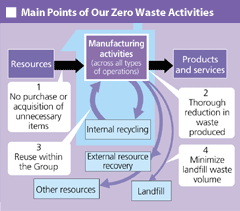
Basic Posture 2: Thorough Risk Management
Integrated Management of Information on Appropriate Handling of Waste Disposal
We implement risk management to ensure that discarded waste is reliably and properly handled. For Group companies in Japan, we have established criteria for selecting waste disposal contractors. Through careful investigation, including preliminary and field surveys, we select reliable contractors who are then registered and managed in a database.
The database also includes a wide range of related information, such as illegal waste disposal, laws and regulations, environmental technologies and other knowledge accumulated within the Group. Such information is managed in an integrated manner, to ensure the most appropriate waste disposal and improve the level of zero waste activities throughout the entire Group.
Results of Resource Recovery
Reducing Landfill Waste Volume through Resource Recovery
In pursuing resource recovery, top priority is given to the in-house recycling of leftover materials produced in the manufacturing process. To facilitate this effort, we research and develop new recycling and production technologies.
Regarding landfill disposal, we feel that the handling of secondary residuals, those that remain after energy recovery and other recycling processes, is also the responsibility of waste producers. Accordingly, we are acutely aware of disposal volume. To reduce landfill volume we thoroughly implement waste separation and select an appropriate recycling route after checking the secondary residual volume.
As a result, in fiscal year 2006, the total waste volume from Group manufacturing sites worldwide was 35,681 tons, the volume of recovered resources (the volume recycled in-house and externally) was 34,500 tons and the landfill volume was 662 tons. Thus, the resource recovery rate was 96.7% and the final disposal rate (landfill rate) was 1.9%.
Total waste volume from Group manufacturing sites in Japan for fiscal year 2006 was 26,916 tons, the volume of recovered resources was 26,356 tons, and the landfill volume was 144 tons. Accordingly, the resource recovery rate was 97.9% and the final disposal rate (landfill rate) was 0.5%.
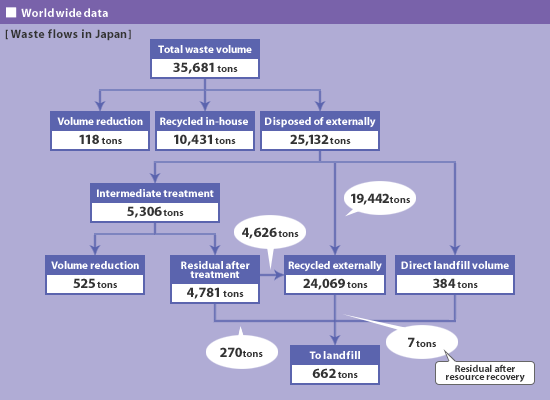
Achieving Zero Waste Targets
Level 1 Zero Waste Criteria Attained at Two Chinese Sites for the First Time outside Japan, and Level 2 at Four Sites in Japan
In fiscal 2006, two Chinese sites achieved Level 1 zero waste goal, the first of its kind outside Japan. This news was covered by many newspapers in China and posted on the Internet. Meanwhile, Level 2 zero waste criteria was attained by two additional sites in Japan.
In fiscal 2007, we will further promote zero waste activities on a worldwide scale.
Sites that achieved zero waste goals in fiscal 2006
Level 1
Wuxi Plant of Konica Minolta Business Technologies (Wuxi) Co., Ltd.
Since October 2005 when it commenced its operation, the Wuxi Plant of Konica Minolta Business Technologies has worked to help establish a recycling-oriented society, on the premise of achieving its zero waste targets. For example, the plant has continued since its inception to implement in-house resource recovery activities through strict waste separation and has selected appropriate recycling contractors based on the same standards as those used in Japan.
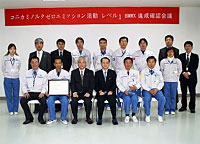
Shilong Plant of Konica Minolta Business Technologies Manufacturing (HK) Ltd.
The Shilong Plant of Konica Minolta Business Technologies Manufacturing (HK) launched initiatives to acquire ISO certification in 1999. As part of such initiatives, the plant has promoted waste reduction activities. Specific efforts include reusing leftovers of plastics molded at this plant, switching from cardboard to plastic containers for product delivery to make them returnable between the plant and suppliers, and thorough reduction of losses in production activities.
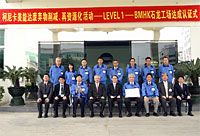
Level 2
Osakasayama Site
Osakasayama Site succeeded in reducing waste glass by preventing product failures due to flaws or other problems in processing glass substrates used in hard disks. It also reduced the amount of cleaning solvents used in the prism cleaning process, achieving significant results.

Hard disk glass substrate
Konica Minolta Opto Products Co., Ltd.
Konica Minolta Opto Products realized a substantial waste reduction, such as by reusing leftover plastics produced during production of aspheric plastic lens for product packaging.

Aspheric plastic lens
Konica Minolta Supplies Manufacturing Kansai Co., Ltd.
The company has made an all-out effort to recycle leftover materials produced in the various processes of toner production as raw materials to create new products, achieving significant waste reduction.
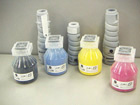
Toner bottle
Toyohashi Precision Products Co., Ltd.
Toyohashi Precision Products reduced a great amount of waste by recycling leftover plastics generated when toner cartridge components are molded as raw materials, and through efforts to eliminate defective products on the toner cartridge assembly line.
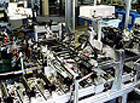
Toner cartridge assembly line
![]()
Toner cartridge
Examples of Recycling Activities Overseas
Recycling Promoted by Overseas Group Companies
Konica Minolta Business Solutions (UK) Ltd., a company selling information equipment in the U.K., is also committed to the best possible recycling of various waste items found at the site, e.g., used products, consumables, and transport pallets. Such resource recovery efforts include unique practices: wooden waste pallets are used for picture frames, crafts, and artistic products, and the document glass plates of copiers are processed into glass products, such as stained and etched glass.
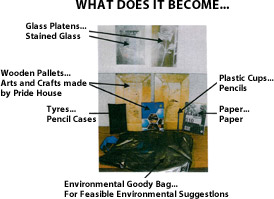
Examples of recycled waste items at our U.K. sales company

